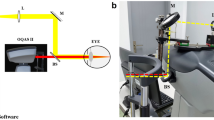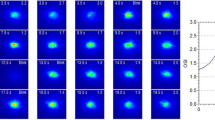Abstract
Purpose
To determine objectively the changes in the optical quality of the air–tear film interface by measuring the modulation transfer function (MTF) of the anterior surface of the film.
Methods
Air–tear film interface MTF was determined from the wavefront aberration obtained from corneal elevation maps and custom software. MTF and Strehl ratio were derived for 3 (photopic) and 7 (mesopic) mm pupils, in 14 healthy young subjects at various intervals after a blink (1 second up to 15 seconds). Fluorescein tear break-up times (TBUT) measured by a standard method were determined for clinical correlation purposes
Results
The MTF profile varies as a function of the time post-blink, showing the highest values at 6–7 seconds. Strehl ratio showed a similar dynamic pattern reaching its maximum level, on average, at 6.2 ± 0.4 seconds after a blink. Minimum levels occur from 10 seconds after a blink, worsening with larger times. Strehl ratio values were correlated with clinical TBUT: minimum values were found to occur earlier for those subjects with shorter TBUT and vice versa.
Conclusion
Air–tear film interface MTF and Strehl ratio estimation are useful metrics for optical quality analysis of tear film changes.




Similar content being viewed by others
References
Montés-Micó R (2007) Role of the tear film in the optical quality of the human eye. J Cataract Refract Surg 33:1631–1635
Montés-Micó R, Alió JL, Muñoz G, Charman WN (2004) Temporal changes in optical quality of air–tear film interface at anterior cornea after blink. Invest Ophthalmol Vis Sci 45:1752–1757
Montés-Micó R, Alió JL, Muñoz G, Pérez-Santonja JJ, Charman WN (2004) Postblink changes in total and corneal ocular aberrations. Ophthalmology 111:758–767
Koh S, Maeda N, Hirohara Y et al (2006) Serial measurements of higher-order aberrations after blinking in normal subjects. Invest Ophthalmol Vis Sci 47:3318–3324
Montés-Micó R, Cáliz A, Alió JL (2004) Wavefront analysis of higher-order aberrations in dry eye patients. J Refract Surg 20:243–247
Montés-Micó R, Cáliz A, Alió JL (2004) Changes in ocular aberrations after artificial tears instillation in dry eye patients. J Cataract Refract Surg 30:1649–1652
Montés-Micó R, Alió JL, Charman WN (2005) Dynamic changes in the tear film in dry eyes. Invest Ophthalmol Vis Sci 46:1615–1619
Koh S, Maeda N, Hirohara Y et al (2008) Serial measurements of higher-order aberrations after blinking in patients with dry eye. Invest Ophthalmol Vis Sci 49:133–138
Benedetto DA, Clinch TE, Laibson PR (1984) In vivo observation of tear film dynamics using fluorophotometry. Arch Ophthalmol 102:410–412
Licznerski TJ, Kasprzak HT, Kowalik W (1998) Analysis of shearing interferograms of tear film using fast-Fourier transforms. J Biomed Opt 3:23–37
Tutt R, Bradley A, Begley C, Thibos LN (2000) Optical and visual impact of tear break-up in human eyes. Invest Ophthalmol Vis Sci 41:4117–4123
Németh J, Erdélyi B, Csákány B et al (2002) High-speed videokeratographic measurement of tear film build-up time. Invest Ophthalmol Vis Sci 43:1783–1790
Himebaugh NL, Wright AR, Bradley A, Begley CG, Thibos LN (2003) Use of retroillumination to visualize optical aberrations caused by tear film break-up. Optom Vis Sci 80:69–78
Montés-Micó R, Alió JL, Charman WN (2005) Postblink changes in the ocular modulation transfer function measured by a double-pass method. Invest Ophthalmol Vis Sci 46:4468–4473
Montés-Micó R, Charman WN (2001) Choice of spatial frequency for contrast sensitivity evaluation after refractive surgery. J Refract Surg 17:646–651
Cho P, Leung L, Lam A, Choi A (1998) Tear break-up test: clinical procedures and their effects. Ophthal Physiol Opt 18:319–324
Novak KD, Kohnen T, Chang-Godinich A et al (1997) Changes in computerized videokeratopraphy induced by artificial tears. J Cataract Refract Surg 23:1023–1028
Huang FC, Tseng SH, Shih MH, Chen FK (2002) Effect of artificial tears on corneal surface regularity, contrast sensitivity, and glare disability in dry eye patients. Ophthalmology 109:1934–1940
Goto E, Yagi Y, Matsumoto Y, Tsubota K (2002) Impaired functional visual acuity of dry eye patients. Am J Ophthalmol 133:181–186
Kopf M, Yi F, Iskander R et al (2008). Tear film surface quality with soft contact lenses using dynamic videokeratoscopy. J Optom 1:14–21
Acknowledgements
This research was supported in part by Ministerio de Ciencia e Innovación Research Grants to Robert Montés-Micó (#SAF2008-01114-E/# and #SAF2009-13342-E#)
Author information
Authors and Affiliations
Corresponding author
Additional information
The authors have no proprietary interest in any of the materials mentioned in this article.
Rights and permissions
About this article
Cite this article
Ferrer-Blasco, T., García-Lázaro, S., Montés-Micó, R. et al. Dynamic changes in the air–tear film interface modulation transfer function. Graefes Arch Clin Exp Ophthalmol 248, 127–132 (2010). https://doi.org/10.1007/s00417-009-1197-0
Received:
Revised:
Accepted:
Published:
Issue Date:
DOI: https://doi.org/10.1007/s00417-009-1197-0




